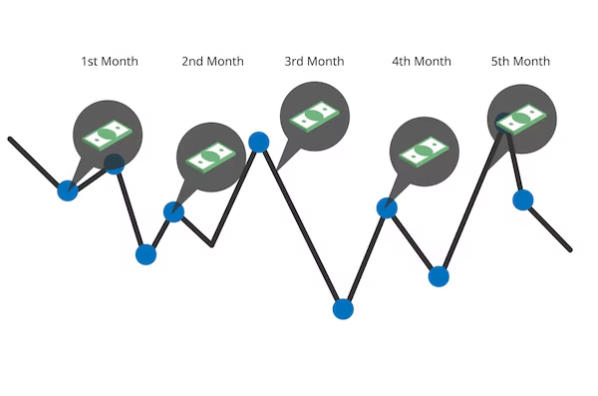
A bear market—defined as a decline of 20% or more in stock prices from recent highs—can be an intimidating experience for any investor.
Market downturns often spark anxiety and a temptation to make impulsive decisions.
However, bear markets are a natural part of the economic cycle, and staying calm while employing smart strategies can turn potential challenges into opportunities.
In this guide, we’ll cover essential tips for navigating a bear market, including risk mitigation techniques and strategies to capitalize on market downturns.
1. Stay Calm and Avoid Knee-Jerk Reactions

The first and most critical step during a bear market is to stay calm. Emotional reactions such as panic selling can lock in losses and prevent you from participating in eventual market recoveries.
Why It’s Important:
- Market Volatility is Normal: Bear markets are temporary and often followed by bull markets. Historically, the stock market has recovered from every downturn, and those who remain invested typically see their portfolios rebound.
- Long-Term Focus: If you’re investing for long-term goals such as retirement, short-term volatility should not drastically alter your strategy.
Action Step:
Review your investment plan and remind yourself of your long-term financial goals. Stay focused on why you invested in the first place, and avoid making hasty changes based solely on fear.
2. Review and Rebalance Your Portfolio

Bear markets provide a good opportunity to assess and rebalance your portfolio to align with your risk tolerance and financial goals. Over time, market fluctuations can cause your asset allocation to drift away from your original targets.
Rebalancing Tips:
- Diversify Your Holdings: Ensure your portfolio is well-diversified across various asset classes (e.g., stocks, bonds, real estate, and international investments) to spread risk.
- Adjust Risk Exposure: If you find your risk tolerance has changed, consider adjusting the balance between high-risk and low-risk assets. For example, increasing bond holdings can provide more stability during uncertain times.
Action Step:
Review your current asset allocation and make adjustments as needed. This could involve shifting a portion of your equity investments into bonds or other safer assets if you feel overexposed to risk.
3. Continue Investing with Dollar-Cost Averaging

Dollar-cost averaging (DCA) is a strategy where you invest a fixed amount of money at regular intervals, regardless of market conditions.
This method allows you to buy more shares when prices are low and fewer shares when prices are high, averaging out the cost over time.
Why It Works:
- Reduces the Impact of Volatility: By consistently investing, you can lower the risk of making poor timing decisions.
- Takes Advantage of Lower Prices: Investing during a bear market allows you to buy quality stocks at discounted prices, setting you up for potential gains when the market recovers.
Action Step:
Set up automatic contributions to your investment accounts to continue investing through market downturns.
This approach helps remove the emotional aspect of investing and ensures that you maintain a long-term perspective.
4. Focus on High-Quality Investments

During a bear market, it’s wise to focus on high-quality investments that have strong fundamentals.
Blue-chip companies with a solid history of profitability, good management, and competitive advantages are more likely to withstand market volatility and recover faster when conditions improve.
Examples of High-Quality Investments:
- Blue-Chip Stocks: Companies like Apple, Microsoft, and Johnson & Johnson that have proven track records.
- Dividend-Paying Stocks: Companies that consistently pay dividends can provide income during downturns and signal financial health.
- Bonds and Treasuries: High-grade bonds and Treasury securities can offer stability and regular income in a declining market.
Action Step:
Review your holdings and ensure that you have exposure to companies with strong balance sheets and resilient business models. Consider shifting a portion of your portfolio to investments with lower risk if needed.
Learn more on making quality investments here!
5. Don’t Try to Time the Market

Attempting to predict when the market will bottom out and when it will start recovering is incredibly difficult, even for seasoned investors. Market timing often leads to missed opportunities and lower long-term returns.
Statistics to Consider:
- Studies have shown that missing just a handful of the market’s best days can drastically reduce your overall returns.
- The market’s best-performing days often occur close to its worst-performing days, making it risky to sell during a downturn and wait for the “right” time to re-enter.
Action Step:
Stick to your investment strategy and avoid the temptation to sell your investments in an attempt to buy back in at a lower price. Remaining invested ensures that you don’t miss out on any sudden market rebounds.
6. Look for Buying Opportunities

Bear markets often create opportunities to buy high-quality assets at discounted prices.
While it can be daunting to invest during a downturn, history has shown that bear markets are often followed by substantial recoveries.
Strategies for Buying in a Bear Market:
- Invest in ETFs or Index Funds: These funds provide broad market exposure and allow you to invest in a diversified portfolio with a single purchase. An S&P 500 index fund, for example, is a popular choice for long-term growth.
- Focus on Sectors That Perform Well in Downturns: Sectors such as healthcare, utilities, and consumer staples often hold up better during market declines due to their essential nature.
Action Step:
Identify strong companies or index funds that align with your investment strategy and consider adding them to your portfolio at lower prices. Ensure you’re comfortable with your overall risk level before making additional investments.
If you want more strategies for buying in a Bear Market, click here!
7. Maintain an Emergency Fund

Having an emergency fund is essential at all times, but it’s especially important during bear markets when economic uncertainty is high.
Knowing you have a financial safety net allows you to avoid selling investments at a loss if you need cash.
Emergency Fund Best Practices:
- 3-6 Months of Living Expenses: Keep enough cash in a high-yield savings account or money market fund to cover at least three to six months of essential expenses.
- Accessible and Liquid: Ensure your emergency fund is easily accessible and not tied up in investments that could be affected by market volatility.
Action Step:
Review your current cash reserves and add to your emergency fund if necessary. This step helps you stay invested during a bear market without worrying about liquidating assets to cover unexpected expenses.
Navigating a Bear Market with Confidence
Bear markets can be unsettling, but with the right strategies, you can navigate them calmly and even turn challenges into opportunities.
By staying focused on your long-term goals, rebalancing your portfolio, continuing to invest with strategies like dollar-cost averaging, and maintaining an emergency fund, you can weather market volatility and position yourself for future gains.
Looking for a Flexible Way to Manage Your Investments?

Consider leveraging the power of a First Lien HELOC to access funds for strategic investments or to bolster your emergency fund during uncertain times.
Try our First Lien HELOC calculator today and see how much equity you can access to strengthen your financial plan.

